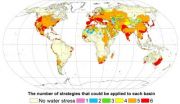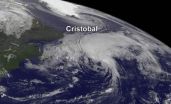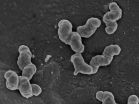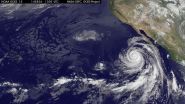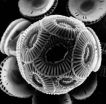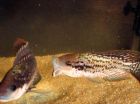(Press-News.org) Boulder, Colorado, USA – In the September issue of GSA Today, Paul Bierman of the University of Vermont–Burlington and colleagues present a cosmogenic view of erosion, relief generation, and the age of faulting in southernmost Africa. By measuring beryllium-10 (10Be) in river sediment samples, they show that south-central South Africa is eroding at the slow rate of about five meters per million years, consistent with rates in other non-tectonically active regions.
By measuring 10Be and aluminum-26 (26Al) in exposed quartzites, Bierman and colleagues find that undeformed upland surfaces have changed little since the Pliocene, with minimum exposure ages averaging 1.3 million years and maximum erosion rates averaging 0.34 meters per million years, and no Quaternary movement on faults that displace the quartzite but not the silcrete-mantled pediment surfaces.
10Be measurements in exposed fault scarp samples from the only recognized Quaternary-active fault are consistent with 1.5 m of displacement occurring at 25,000 years ago. They conclude that rates of landscape change on the upland pediment surfaces are an order of magnitude lower than basin-average erosion rates and that, as isostatic response to regional denudation uplifts the entire landscape at several meters per million years, valleys deepen, isolating stable upland surfaces and creating the spectacular relief for which the region is famous.
INFORMATION:
ARTICLE
A cosmogenic view of erosion, relief generation, and the age of faulting in southern Africa
Paul R. Bierman et al., Geology Dept. and Rubenstein School of the Environment and Natural Resources, University of Vermont, Burlington, Vermont 05405, USA, Pages 4-11 doi: 10.1130/GSATG206A.1.
GSA Today articles are open access online; for a print copy, please contact Kea Giles. Please discuss articles of interest with the authors before publishing stories on their work, and please make reference to GSA Today in articles published.
http://www.geosociety.org/
Aging Africa
September 2014 issue of GSA Today
2014-08-29
ELSE PRESS RELEASES FROM THIS DATE:
Preventing cancer from forming 'tentacles' stops dangerous spread
2014-08-29
EDMONTON, AB – A new study from the research group of Dr. John Lewis at the University of Alberta (Edmonton, AB) and the Lawson Health Research Institute (London, ON) has confirmed that "invadopodia" play a key role in the spread of cancer. The study, published in Cell Reports, shows preventing these tentacle-like structures from forming can stop the spread of cancer entirely.
Roughly 2 in 5 Canadians will develop cancer in their lifetime, and one in four of them will die of the disease. In 2014, it's estimated that nine Canadians will die of cancer every hour. Thanks ...
Reducing water scarcity possible by 2050
2014-08-29
Water scarcity is not a problem just for the developing world. In California, legislators are currently proposing a $7.5 billion emergency water plan to their voters; and U.S. federal officials last year warned residents of Arizona and Nevada that they could face cuts in Colorado River water deliveries in 2016.
Irrigation techniques, industrial and residential habits combined with climate change lie at the root of the problem. But despite what appears to be an insurmountable problem, according to researchers from McGill and Utrecht University it is possible to turn the ...
Evidence mounting that older adults who volunteer are happier, healthier
2014-08-29
Toronto, Canada – Older adults who stay active by volunteering are getting more out of it than just an altruistic feeling – they are receiving a health boost!
A new study, led by the Rotman Research Institute at Baycrest Health Sciences and published online this week in Psychological Bulletin, is the first to take a broad-brush look at all the available peer-reviewed evidence regarding the psychosocial health benefits of formal volunteering for older adults.
Lead investigator Dr. Nicole Anderson, together with scientists from Canadian and American academic centres, ...
NASA sees Hurricane Cristobal racing through North Atlantic
2014-08-29
Satellite imagery shows Hurricane Cristobal racing through the North Atlantic on Friday, August 29 while losing its tropical characteristics. An image from NOAA's GOES-East satellite showed Cristobal headed south of Greenland. The previous day, NASA's TRMM satellite saw heavy rainfall occurring in the hurricane.
In a visible image from NOAA's GOES-East satellite on August 29 at 7:45 a.m. EDT, Hurricane Cristobal was moving through the North Atlantic about 500 miles southwest of Greenland. The image was created by the NASA/NOAA GOES Project at NASA's Goddard Space Flight ...
CCNY team defines new biodiversity metric
2014-08-29
To understand how the repeated climatic shifts over the last 120,000 years may have influenced today's patterns of genetic diversity, a team of researchers led by City College of New York biologist Dr. Ana Carnaval developed a new biodiversity metric called "phylogeographic endemism."
It quantifies the degree to which the genetic variation within species is restricted in geographical space.
Dr. Carnaval, an assistant professor of biology, and 14 other researchers from institutions in Brazil, Australia and the United States, analyzed the effects of current and past climatic ...
Hydrogen powers important nitrogen-transforming bacteria
2014-08-29
This news release is available in German. Nitrite-oxidizing bacteria are key players in the natural nitrogen cycle on Earth and in biological wastewater treatment plants. For decades, these specialist bacteria were thought to depend on nitrite as their source of energy. An international team of scientists led by Holger Daims, a microbiologist at the University of Vienna, has now shown that nitrite-oxidizing bacteria can use hydrogen as an alternative source of energy. The oxidation of hydrogen with oxygen enables their growth independent of nitrite and a lifestyle outside ...
NASA animation shows Hurricane Marie winding down
2014-08-29
VIDEO:
This video of NOAA's GOES-West satellite imagery from Aug. 26-29 shows Hurricane Marie winding down into a post-tropical storm.
Click here for more information.
NOAA's GOES-West satellite keeps a continuous eye on the Eastern Pacific and has been covering Hurricane Marie since birth. NASA's GOES Project uses NOAA data and creates animations and did so to show the end of Hurricane Marie.
At 5 a.m. EDT (0900 UTC) on Friday, August 29, Marie became a post-tropical storm ...
'Face time' for the heart diagnoses cardiac disease
2014-08-29
To the careful observer, a person's face has long provided insight into what is going on beneath the surface. Now, with the assistance of a web camera and software algorithms, the face can also reveal whether or not an individual is experiencing atrial fibrillation, a treatable but potentially dangerous heart condition.
A pilot project, the results of which were published online today in the journal Heart Rhythm, demonstrates that subtle changes in skin color can be used to detect the uneven blood flow caused by atrial fibrillation. The technology was developed in a ...
Not all phytoplankton in the ocean need to take their vitamins
2014-08-29
Some species of marine phytoplankton, such as the prolific bloomer Emiliania huxleyi, can grow without consuming vitamin B1 (thiamine), researchers have discovered. The finding contradicts the common view that E. huxleyi and many other eukaryotic microbes depend on scarce supplies of thiamine in the ocean to survive.
"It's a really different way to think about the ocean," says CIFAR Senior Fellow Alexandra Worden, co-author on The ISME Journal paper with CIFAR fellows John Archibald (Dalhousie University), Adrián Reyes-Prieto (University of New Brunswick) and three lead ...
Ready for mating at the right time
2014-08-29
This news release is available in German. The exchange of chemical signals between organisms is considered the oldest form of communication. Acting as messenger molecules, pheromones regulate social interactions between conspecifics, for example, the sexual attraction between males and females. Fish rely on pheromones to trigger social responses and to coordinate reproductive behavior in males and females. Scientists at the Marine Science Center at the University of the Algarve in Faro, Portugal, and at the Max Planck Institute for Chemical Ecology in Jena, Germany, ...
LAST 30 PRESS RELEASES:
Valvular heart disease is common in cancer patients but interventions improve survival
When socially responsible investing backfires
Cuffless blood pressure technologies in wearable devices show promise to transform care
AI-based tool predicts future cardiovascular events in patients with angina
Researchers map how the cerebellum builds its connections with the rest of the brain during early development
Routine scans could detect early prostate radiotherapy changes
Fairness in AI: Study shows central role of human decision-making
Pandemic ‘beneath the surface’ has been quietly wiping out sea urchins around the world
Tea linked to stronger bones in older women, while coffee may pose risks
School feeding programs lead to modest but meaningful results
Researchers develop AI Tool to identify undiagnosed Alzheimer's cases while reducing disparities
Seaweed based carbon catalyst offers metal free solution for removing antibiotics from water
Simple organic additive supercharges UV treatment of “forever chemical” PFOA
£13m NHS bill for ‘mismanagement’ of menstrual bleeds
The Lancet Psychiatry: Slow tapering plus therapy most effective strategy for stopping antidepressants, finds major meta-analysis
Body image issues in adolescence linked to depression in adulthood
Child sexual exploitation and abuse online surges amid rapid tech change; new tool for preventing abuse unveiled for path forward
Dragon-slaying saints performed green-fingered medieval miracles, new study reveals
New research identifies shared genetic factors between addiction and educational attainment
Epilepsy can lead to earlier deaths in people with intellectual disabilities, study shows
Global study suggests the underlying problems of ECT patients are often ignored
Mapping ‘dark’ regions of the genome illuminates how cells respond to their environment
ECOG-ACRIN and Caris Life Sciences unveil first findings from a multi-year collaboration to advance AI-powered multimodal tools for breast cancer recurrence risk stratification
Satellite data helps UNM researchers map massive rupture of 2025 Myanmar earthquake
Twisting Spins: Florida State University researchers explore chemical boundaries to create new magnetic material
Mayo Clinic researchers find new hope for toughest myeloma through off-the-shelf immunotherapy
Cell-free DNA Could Detect Adverse Events from Immunotherapy
American College of Cardiology announces Fuster Prevention Forum
AAN issues new guideline for the management of functional seizures
Could GLP-1 drugs affect risk of epilepsy for people with diabetes?
[Press-News.org] Aging AfricaSeptember 2014 issue of GSA Today

